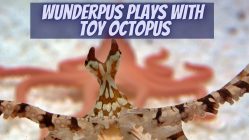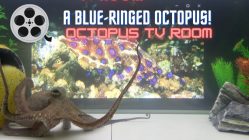Meet the Octopus
Are you an octopus amateur? Or perhaps a marine biologist? How much do YOU know about this animal called the octopus?
Whether the octopus has been just a tasty meal for you up to this moment or you are the greatest octopus enthusiast in your region, you probably ended up reading this in search of some more information about our little eight-armed friends.
Let’s start with some basics.
First and most important, the spelling: you will often encounter the spelling octopi as the plural form of octopus, but the correct plural form is octopuses.
The octopus is:
- An invertebrate meaning that it does not possess a spine.
- A mollusc, which is a phylum of the invertebrate animals. Almost one quarter (23%) of all marine animals are molluscs. But the majority of molluscs are terrestrial organisms: 80% of all molluscs are gastropods (snails, slugs etc.) One of the main characteristics of the mollusc is the existence of a mantle cavity. The word mollusc derives from the ancient Greek word “malákia” which means soft.
- A cephalopod, which is a class of molluscs, containing also squids and nautiluses. They are otherwise known as inkfishes as they are all able to expel ink. The word cephalopod translates from Greek as head-feet. They are named like that to refer to their prominent heads and pairs of arms or tentacles.
The word Octopus itself literally means eight-feet (from Ancient Greek words “okto” meaning eight and “pus” meaning foot). In theory, there are approximately 300 species of octopuses. Some of these species have minute differences with each other, which can be so trivial that scientists question their separate existence.
Now that we have aced the classification course, let’s move to the next lesson. Unless, of course, you are afraid you are going to fail the class in which case it is a good idea to carefully study our special handbook, Classifying Types of Octopus for Dummies.
What Does An Octopus Look Like?
Is it small? Is it big? How can you tell it is an octopus and not an elephant?
Octopuses are relatively small. They can be as small as an inch (2,5 cm) but they can be as gigantic as 30 feet long (more than 9 meters)! If 30 feet sound a bit exaggerated, read more about the Largest Octopus Ever found. If, on the other hand, you believe that the smaller the cuter, you might be interest in 7 Small Octopus Species That You’ll Love.
The smallest known octopus species is called the Wolfi Octopus whereas the biggest is the Giant Pacific Octopus.
As most of us are not actually marine biologists, we do not get the chance to come across lilliput or colossal octopuses so often. If you happen to encounter an octopus while scuba diving, it will most probably be a Common Octopus, which is of average size, about three feet long.
The most prominent features of the octopus is its head and arms. The head of the octopus is known as the mantle and its cavity contains and protects most of its organs. The arms are normally eight. Each arm has two rows of extremely powerful suckers.
The looks of the octopus are very deceiving. The main reason why you do not know how an octopus looks like is because it is, in fact, quite difficult to spot one. Octopuses have an amazing ability of camouflaging in order to blend in with their surrounding environment. Their skin contains pigments cells called chromatophores which are responsible for their rapid color changing. The octopus can change both the color and the texture of its skin. So what your untrained eyes perceive as a spiky coral, might actually be an effectively camouflaged octopus.
Where Can I Find One?
Contrary to some myths and theories, octopuses are strictly marine and can only survive in saltwater environment. Octopuses are always on the move in search for more available food sources. Some octopus species are characterized as deepwater and prefer deeper depths of the ocean while other species inhabit shallow waters. Larger deepwater species are able to survive colder temperatures but most species prefer warmer water temperatures. Even species inhabiting the darkest parts of the deep ocean often seek nearby hot springs in order to lay their eggs.
Most octopus species live on the ocean floor. They choose their hideouts inside rocks and corals lying on the bottom of the sea. However, a group of species known as the argonauts can be found drifting near the surface of the sea or swimming at a mid-depth range.
All in all, you can find an octopus literally everywhere where there is sea water.
Some Anatomy Basics
As we mentioned above, the head of the octopus is known as the mantle. The mantle is bulb-shaped and hollow and contains all the vital organs of the octopus as well as the digestive, reproductive, excretory, and respiratory systems. The main body parts located in the mantle are the brain, the hearts, the gills, the ink sac, and the ovaries of the female.
An octopus has one brain located in its head. However, unlike other creatures, not all of its neurons are located in its brain. An amount of 30 to 40 percent of the neurons reside in its central brain. The remaining neurons are distributed throughout the animal’s eight arms. The octopus can receive sensory input from the arms and process it in a remote way without having to route it first to the main brain. The complexity of the brain as well as the sophisticated nervous system are responsible for the advanced cognitive behaviors of the octopus that are superior to those of its invertebrate relatives.
One of the most curious facts regarding the anatomy of the octopus is that it has not one, not even two, but three hearts to circulate the blood around its body! All cephalopods have a heart above each gill (called the branchial hearts) and one central heart (the systemic one) which pumps the blood around the body.
Did you know that the octopus has blue blood instead of red? This is because the blood cells of the octopus are rich in haemocyanin, which is copper-based instead of the iron-based.
When the octopus feels threatened or surprised, it will suddenly release a cloud of ink which is produced in the ink sac. When the octopus feels threatened or surprised, it will suddenly release a cloud of ink which is produced in the ink sac. It contains the ink that can be squirted towards the octopus’ predators.
As it is generally very difficult to distinguish between a male and a female octopus, most scientists do so by searching inside the mantle of a specimen for the ovaries. Another way to distinguish the gender of the octopus while it is alive is to search for an arm called the hectocotylus. The hectocotylus is a modified arm used to carry the spermatophores. The tip of this arm is different as it bears no suckers.
The funnel, otherwise known as the siphon, is a tube-shaped organ attached to the mantle. The octopus uses it to propel itself while swimming. It can suddenly release water to scare off annoyances.
The octopus has eight limbs, two of which function as legs while the remaining six function as arms. Octopuses need their arms to perform basic functions. These functions include walking, moving, hunting for food, manipulating objects, tasting, sensing, and so much more.
What Do Octopuses Eat?
What an octopus eats depends on its own size and where it lives. Octopuses show a preference for crustaceans — such as shrimp and crabs — as well as larger gastropods, such as clams and mussels. Baby octopuses feed primarily on plankton. Larger octopuses will consume larger prey, such as bigger fishes, squid, eels, sharks or even other, smaller octopuses.
Octopuses have a mouth which not easily discerned, as it is hidden in the middle of the web that connects the eight arms of the octopus. This hidden and small part of the octopus is, in fact, a lethal weapon. It contains the beak of the octopus which is retractile and hard. It looks very similar to the beak of the parrot and it is an extremely powerful and useful tool. It is sharp enough to tear the flesh of the prey apart and competent enough to break the shells of clams open. Octopuses are able to swallow entire pieces of their meals.
Inside the beak, there is a structure similar to a tongue called the radula, which aids the feeding process as it allows the octopus to ‘lick’ the inside of a shell.
Pet Octopuses
If you are an octopus fanatic, you might be tempted to adopt one as a pet. The octopus adapts well to life in an aquarium.
However, be aware! The octopus has a very short life expectancy. The lifespan of the Common Octopus is approximately 2 years. This means you will have to cherish every moment with your pet octopus as the time to say goodbye will come sooner than with your cat or dog.
To keep an octopus in an aquarium you will have to take care of the water and temperature conditions. Make sure you provide a suitable den where your octopus can hide.
Watch how fun it was for Nora to choose her own hideout.
If you keep an octopus in an aquarium it is imperative that it have a tight-fitting and secure lid. This is because octopuses are nature’s best escape artists.
Never place the aquarium where it comes into direct sunlight. Also, keep in mind that octopuses prefer dimly lit aquariums.
It is ideal to feed your pet octopus live prey. If this is not possible, you can feed them dead shrimp, crab meat, etc. Just make sure that it is as fresh as possible and not frozen. Your octopus should be fed at least once per day. You also need to clean the remnants of its meal.
Reproduction and Life Cycle
Octopuses are oviparous, meaning that the females lay eggs. As soon as the eggs hatch, the newly-born octopuses will start developing in a extremely fast rate. The babies will increase their weight up to 5% each day until they reach their adult size. Adulthood signals the beginning of the mating stage.
Octopuses have several mating rituals. For example, the male octopus will approach the female and caress her with his modified arm known as the hectocotylus. Most species will insert this modified arm into the female’s mantle cavity and release the packages of sperm (the spermatophores) while some species will self-amputate the hectocotylus and present it to the female. The Argonaut females, for example, can store many different hectocotyluses in their mantles and use them when the time comes to fertilize their eggs.
The female octopus lays dozens of eggs. The number of eggs depends on the species. The Giant Pacific Octopus, for example, can lay as many as 400,000 eggs. Females spend considerable time looking for an ideal cave or den to lay her eggs.
Female octopuses are highly devoted and meticulous mothers. They remain close to their eggs for the long brooding period, protecting them from predators and blowing with their funnels oxygenating water over the eggs in order to keep them clean. The brooding period lasts for months, and even years for some deep-sea species. All this time, the female will not even move away to hunt.
The octopus love story is a tragic one. Octopuses are what scientists call semelparous animals. This means that they only mate once in their life and soon die. The male octopus will enter the stage of senescence as soon as he mates whereas the female will wait until all eggs have hatched.
The young larval octopuses will start their lives drifting in clouds of plankton while feeding on it. Most of the newly-borns will die during this stage as they will be devoured along with the plankton. The few survivors will move to the benthic zone where they will continue fighting for their survival.
Survival Of The Fittest
The ocean is a dangerous place for an octopus. Many are the predators that would give quite a fight to ensure a tasty,healthy, and full of protein octopus meal. The octopus predators vary from large animals such as sharks, dolphins, and seals to smaller fishes, rays, eels, and even diving birds. Octopuses have even exhibited cannibalism, with larger octopuses hunting down smaller ones.
Luckily for the octopus, it has many effective defense mechanisms which contribute to its survival. Small octopuses can squeeze into very small holes and openings where they remain hidden and safe. In case it is caught out in the open, the octopus employs its master camouflaging techniques to hide from the eyes of the predator. It can hide in plain sight by blending in with the environment or it can even acquire the shape and color of other animals in order to confuse its attacker.
If it is spotted, however, the octopus can suddenly release an amount of ink from its ink sac to scare off the enemy or blind him temporarily until it has time to escape. Fleeing the battlefield can be even quicker by expelling water through the funnel and generating a propelling force.
When an octopus must engage in battle, its most powerful defense advantage over its enemies are its eight mighty arms. The suckers on each arm can attach themselves to the enemy’s skin and allow the octopus to grasp and entangle the enemy. Finally, a poisonous bite to the enemy can paralyze him long enough for the octopus to flee.
Unique Octopus Species and Special Traits
Of the approximately 300 species, there are some that we consider unique as they are characterized by something extraordinary. Here are some examples of such particular species:
- The Blue-Ringed Octopus is an octopus genus with poison so toxic that can be lethal even for humans. When the blue-ringed octopus becomes agitated or feels that it is in danger it will literally begin to shine
- The Blanket Octopus is an open sea genus notorious for their extreme sexual dimorphism. The female blanket octopus is 80 to 100 times longer and 10,000 times heavier than the male!
- The Flapjack Octopus is probably the cutest species. It is also the most compressed species in the anterior-posterior axis.
- The Argonaut Octopus is a genus of truly unique octopuses as they have a shell that allows them to drift near the surface of the sea.




















